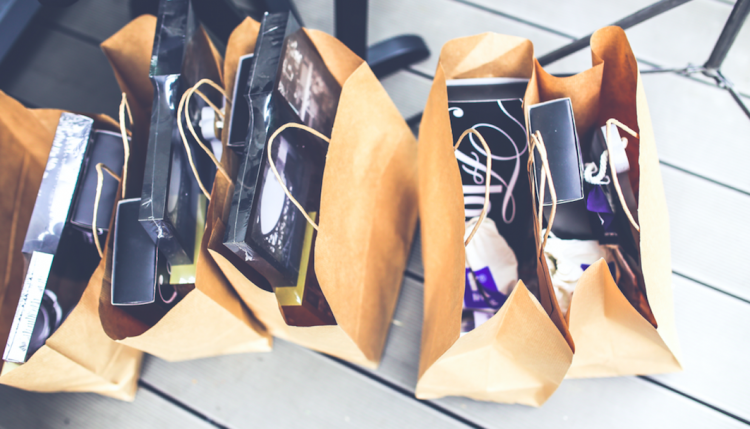As an ecommerce merchant, you can’t wait for the holiday season.
November and December, two of the most popular shopping months, each bring 30% more ecommerce revenue than non-holiday months. It all begins with Thanksgiving as consumers take off work to celebrate with their families and retailers offer major online promotions and discounts. In 2016, Thanksgiving weekend (which includes Black Friday and Cyber Monday) brought in over $7.9 billion of online sales. This year, ecommerce merchants have long been gearing up for the festivities starting November 23rd.
But what happens after the holiday season? After this huge influx of business, sales not surprisingly start to fall in January and beyond. Many shoppers take advantage of holiday sales but the vast majority don’t re engage with those same brands for the rest of the year. They enjoy the one-time deals, but then forget all about the brand.
Image via Online-Metrics
Take a look at the graph above representing Amazon’s sales. Two things about this graph stand out. The most obvious is the Q4 spikes they consistently experience year-by-year. This represents a massive bump in revenue, but we’re more interested in the upward trend line they’re enjoying.
Amazon experiences the holiday rush just like every other ecommerce business, but the following Q1 always outperforms the Q3 before the holiday madness. This is one of the biggest secrets to their sustained success: When Amazon attracts new customers or sells to inactive old ones for the holidays, they don’t let them go.
Every ecommerce merchant has the ability to extract more value from one-time shoppers by setting them up to be “reactivated” and turned into year-round repeat purchasers.
The key to accomplishing this is through a dynamic marketing strategy.
What is a Dynamic Marketing Strategy?
Promotions tend to lose their efficacy with the same returning customers year-round. One deal that started off successfully may not always work next month or even next week.
Why? A fad may have died out, a social media platform is being used less, an upcoming holiday is consuming everyone’s attention, or any number of other reasons.
Smart marketers create a dynamic, or constantly evolving, marketing strategy to make sure that they are appealing to all their customers and their changing needs. To do so, they are constantly experimenting with new forms of communication techniques and analyzing the results.
Types of Dynamic Promotions
Image via Nielson
Dynamic marketing strategies require both studies of both circumstances and analytics (example depicted above).
Using Circumstantial Promotions
Marketers are aware of changing general climates and how they impact consumer buying habits. They follow news reports and upcoming events to anticipate changes. For example: Just prior to the Winter Olympics, an athletic apparel store would take advantage of the increased winter sports media attention by offering a “20% Off” promotion on cold weather gear.
Using Analytics-Based Promotions
Marketers use analytics to understand their consumer buying preferences. They ask questions like: What social media channels are my consumers most active on? What days do they most frequently read our blog posts? What discounts are most appealing to them? Using data, marketers can analyze the results of their experiments. For example:An activewear clothing line that sees a high percentage of their Facebook followers are high volume customers may want to offer direct incentives to customers who choose to follow their brand on Facebook.
Leveraging both styles of promotions creates a strategy that encourages shoppers to stay engaged throughout the year. In our next section, we cover how you can capitalize both types of promotions to achieve lasting growth and success.
3 Dynamic Marketing Practices to Reactivate One-Time Black Friday Shoppers
1. Diversify Your Outreach Strategy
The Platinum Rule of marketing in the online era: advertise to your customers where they prefer to be reached. You won’t know what that preferred method is until you test all of your avenues to pull back disengaged customers. The number of communication mediums is endless, but using social media channels, email, or retargeted ads on third-party websites are typically the most powerful.
A study by MailMunch analyzed click-through rates of various communication mediums. They found that email performed the best (3.57%), followed by Facebook (0.07%) and Twitter (0.03%). However, because every ecommerce store has different customers, test out multiple marketing avenues yourself to see which platform works the best.
The important takeaway here is that the most successful outreach strategies use many different mediums to communicate with the customers and engage with the largest possible percentage of them.
Happiest Baby, an ecommerce store selling smart sleeping products, builds customer relationships heavily through social media. The company takes advantage of Facebook, Twitter, Instagram, Youtube, and Pinterest to attract social media users on all the main platforms. While some consumers may find them through their an ad on Facebook, others come across a video on their Youtube page, a popular tweet, etc.
They also maintain an active presence in the press and have positioned themselves well as a thought leader in their space with their active blog presence.
Coupled with powerful email marketing campaigns the Happiest Baby outreach strategy is built to persistently interact holiday shoppers long after the holiday season has come and gone.
After the Holidays: Create various campaigns to promote and engage visitors through multiple mediums. Make sure that you are sending content to the places where consumers want to receive it. Sample strategies include sending out emails a month after Thanksgiving promoting a Christmas discount or placing retargeted ads on websites similar to yours.
2. Vary Discounts
Just because a promotional strategy worked once with a customer doesn’t mean it’ll be similarly impactful with the same consumer in the future. That’s why it’s important to vary your discounts, either through a loyalty program or a temporary discount code. Some consumers may prefer credit discounts, while others prefer a percentage off their sales. You can easily figure this out by A/B Testing both ideas.
In the Obviously Chic loyalty program, users earn points through creating an account, spending money, and interacting on social media. They can exchange their points for discounts for future purchases.
Using a program that offers multiple discounts like theirs allows Obviously Chic to get a consistent read on redemption trends. Are their customers more likely to save up their points and want to redeem for bigger discounts? Or are they content to make more frequent purchases and use the smaller discounts? Looking at simple statistics such as coupon-by-coupon redemptions can go a long way to helping their team optimize their discount strategy.
After the Holidays: Testing out different ways to reward your customers is very beneficial. Use the time in early January to experiment with varied discounts, finding out which one leads to more conversions.
3. Manufacture Demand and Urgency
Expiring promotions and limited-edition products create the feeling of exclusivity. Coupons are proven to improve sales when influencing decision-making–that is, a 10% discount usually works better than a product normally priced for $15 that’s on sale for $10.
Leverage your spike in holiday traffic to advertise promotions that will keep customers interested in your store beyond their initial purchase. A delayed release can be a powerful strategy to generate additional traffic in January and beyond.
Selling a particular product as “limited edition” on Black Friday, and just before the December Holidays and advertising a release of a new related product in late January will stand out to shoppers during the holiday madness, even if only for a second. This reminds them that they could get value out of coming back to shop with your store in the future.
Furthermore, a study by Shopify found that stores that use a “countdown timer” in their product page converted 9% more purchases than a variation without the timer. These tools will draw people back to your website and keep you at the front of your customer’s minds even if they’re not yet ready to make another purchase.
Perfect Locks, which sells hair extensions, flashes a pop-up when users first visit their site. Notice the messaging at the bottom: a “one-time” coupon which expires in “2:25 seconds”. The urgency in their messaging may incentivize customers to take advantage of the discount and make a purchase before looking for a competitor.
After the Holidays : Offering expiring coupons, limited products, and flash sales will help manufacture urgency to your buyers. Make sure that your messaging is also strong by using phrases such as “limited quantity available,” “offer ends in the next hour,” and “act now while supplies last.” Although cliché, using these messages will incentive your consumers to purchase products. Use the time after Thanksgiving to test out these tools.
While trying out a dynamic marketing strategy, keep in mind these three useful practices. It’s important to remember that just as a company is constantly moving and changing, so too are its consumers. By keeping up with the latest consumer trends and measuring data related to their buyer habits, you will be able to reactivate one-time Holiday shoppers more often and develop longer-lasting, higher-value relationships.











